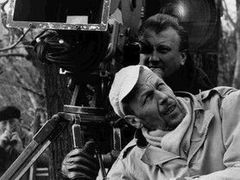Prague - The exhibition called "The Battles of František Vláčil" introduces the life and work of a director considered to be one of the most significant in Czech cinematography and culture.
"František Vláčil was a very gentle person, and considering all that he went through, during the course of his life, it was indeed a big battle for him," says Pavel Jiras, the exhibition curator.
"By that I mean the hassle from the communist authorities that he faced and that only complicated his creative life. Or his battle with the film production itself, as he allowed only perfection and nothing else."
Alcohol was the next demon Vláčil fought and it took its toll on him. "Sometimes he was able to control the demon, and sometimes not. In a way, it was a never-ending battle with himself," adds curator Jiras.
František Vláčil was about to turn 75 when he died in 1999.
Battle in film production field
Vláčil, often nicknamed Czech Akira Kurosowa or Ingmar Bergman, has made close to thirty movies and some of them have become classics, being screened in club cinemas regularly.
The Valley of the Bees (Údolí včel), being among them, tells a story of a young man, a runaway from the Brotherhood of Teutonic Knights, who marries and lives a normal life when he is confronted with his friend, a devoted and bigoted member of the Brotherhood, in other words fundamentalism is juxtaposed to individual expression.
Adelheid (Adelheid) describes the aftermath of World War II in Czecholslovakia, during which a former Czech soldier falls in love with a German girl. His deep emotions for Adelheid being a daughter of the enemy, however, trouble his conscience.
Vláčil also directed several innovative children's movies such as, The Valley Herd (Pasáček z doliny), The Sirius (Sírius) and Shades of Fern (Stín kapradiny), based on a book by Czech writer Josef Čapek.
Marketa Lazarová, the best Czech film
Undeniably of course, Vláčil´s most famous film, and the film he is most remembered by many, remains Marketa Lazarová, a grimy 13th century account of the times when pagans were turning Christians, full of images of hunters and bandits, marsh reeds and wolves howling and hawks hovering.
But it is also a balladic love story of a young girl Marketa who is about to enter a convent but falls in love with Mikoláš, the bandit. The predatory world and survival are the key issues established in the film.
To make the film appear as authentic as he could, he took the actors to the forest of Šumava in south-east Bohemia where they lived for some time like their counterparts in the film, lacking food and dressed in rags. Vláčil once said of the filming: "There we lived like animals. We had no food and our clothes turned into rags. I wanted my actors to live their parts. And they did. And what more, they loved me for that because I gave them a chance to live the way they always wanted."
Film critics labeled Marketa Lazarová as the best Czech movie ever made.
His movies are also known for the fact that it was also scored by one of Czechs best film music composer, Zdeněk Liška.
"The fact is that Marketa Lazarová belongs in the category of the world's best historical movies, which I actually found out in the San Francisco Art Institute," recalls actress Magda Vašáryová, who was cast as Marketa Lazarová.
"In 1980 I actually went to the United States for the casting of Sophie's Choice. Then they showed me all the pictures from the film and reviews written about the film, and I was shocked. The film Marketa Lazarová was a lost case for us here in Czechoslovakia."
Vláčil goes multimedia
If you want to be able to capture the mysterious characteristics and dismal atmosphere in some of Vláčil´s movies, you can also visit the multimedia exposition.
"All his movies literally define humanity. The qualities shown in them are permanent to this day," confirms Pavel Jiras.
The exhibition offers many unique elements, even unpublished photos either from the actual shooting of his movies or from his private life.
You can find a number of great actors in those photos, Czech actors who created his main characters, namely Josef Kemr, Vladimír Menšík, Věra Galatíková and Petr Čepek.
The projections of fragmented film reels are also included in this exhibition. "We hope that people would leave their worries behind and could enjoy the beauty of the film work," says the curator.
Other attractions
The exhibition´s main attraction might as well be the multimedia tree speaking to the audience with Vláčil's voice attached.
Another architectural component is the placement of some of the pictures above on the high ceiling. And finally, in the final part of the exhibition, there is a duplicate of the Director's office.
Exhibitions of the works of other famous Czech film makers including Miloš Forman, Karel Kachyňa or Gustav Machatý are already being planned by Barrandov Studios.
This exhibition is open until the May 31st in The Caesar Hall of The Prague Castle, in association with Barrandov Studios. Opening hours are from 10am to 6pm daily.








